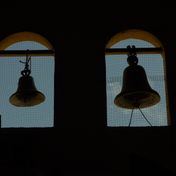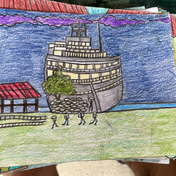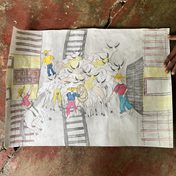
Daniel Bustos-Echeverry's A Future Buried in the Past (2023) explores the overlooked history of Cuban cultural colonization in Sincerín, Colombia, between 1909 and 1953, through a collaborative process with César Villa Gutiérrez, a self-taught historian and “primitivist” artist. Together, they construct a counter-archive that reclaims the voices of marginalized workers often excluded from official histories. Central to Bustos-Echeverry's approach is “painting-elicitation,” where Villa's artwork prompts memories from Sincerín's elders. This method goes beyond traditional interviews by creating a visual dialogue between past and present. For example, Villa’s painting El Viaje del Azúcar, presented at the ruins of the Ingenio’s port—now a marshland—interacts with the contemporary landscape, evoking both historical continuity and loss. Bustos-Echeverry’s collaboration with Villa reflects a shift toward more participatory ethnographic practices, aligning with efforts to decolonize anthropology and filmmaking. Unlike many ethnographic films that blur the roles of collaborators, here Villa’s position as an artist is clearly distinct from Bustos-Echeverry’s role as a filmmaker. The film avoids explanatory narration, instead offering an immersive sensory experience that juxtaposes Villa’s paintings with contemporary landscapes, incorporates archival footage to layer temporalities, and integrates elements of the filmmaking process into its narrative. Ethical considerations are central to this work, as they are in ethnographic and Indigenous filmmaking more broadly. These considerations tackle issues of representation, power dynamics, collaboration, and cultural appropriation. In his article “Seven Types of Collaboration,” David MacDougall emphasizes the complexities of collaboration in Indigenous filmmaking:
Next to the benefits of subject collaboration one must consider the limitations. As I mentioned earlier, any form of collaboration requires compromise, but when there is a considerable gap between the backgrounds and interests of the filmmaker and subject, the compromises may result in a kind of double negation, so that the interests of neither are properly expressed, or else remain blurred. It may be impossible to know whose perspective the film finally represents. My experience of collaborating with film subjects, which initially I embraced, has convinced me that the resulting ambiguity often constrains both parties. It may be far better to create the conditions in which each can make their own films, or failing this, construct films (such as by alternating scenes) to show their two different perspectives. This stance retains and reaffirms the value of individual authorship (MacDougall 2022, 27)
These challenges highlight how collaboration alone cannot fully address issues of representation or power imbalances in ethnographic work. The film has also faced criticism. Catalina Muñoz-Roja’s contribution to this review series questions its reliance on oral testimonies as a means of recovering history and archives. While this approach is commendable for amplifying marginalized voices, she argues it risks reinforcing assumptions about such voices as inherently immaterial. Muñoz-Rojas points out that during Ingenio Central Colombia’s operation, community members actively engaged with conventional archival systems to document their perspectives in writing—challenging narratives that depict them as passive or voiceless. This critique aligns with José Esteban Muñoz’s concept of ephemera as evidence (1996). Muñoz describes ephemera as traces or remnants left after performances—forms of evidence that defy rigid epistemological frameworks but expand understandings of materiality through memory and alternative modes of storytelling. Bustos-Echeverry addresses some longstanding ethical concerns in ethnographic filmmaking by involving Sincerín’s community in storytelling processes and acknowledging his own positionality as a filmmaker. This approach resonates with Faye Ginsburg’s description of media’s ability to “transcend boundaries of time, space, and language,” mediating historical ruptures while constructing identities that the past and present in ways relevant to contemporary conditions (1991).
By creating space for marginalized voices through collaboration and artistic techniques, Bustos-Echeverry engages with complex questions about representation without claiming definitive answers. Peter Wade highlights how A Future Buried in the Past constructs a counternarrative that complements conventional records instead of opposing them outright. He notes Bustos-Echeverry’s dual role as both an anthropologist and metadata provider for Villa’s artistic work—a dynamic that effectively navigates sensitive topics while maintaining scholarly rigor. While innovative in its methods, Bustos-Echeverry’s approach raises broader questions about balancing artistic interpretation with historical accuracy. The potential for romanticizing history through art must be considered alongside challenges related to scaling such collaborative methods across different contexts. Ultimately, A Future Buried in the Past offers an example of how ethnographic filmmaking can combine artistic collaboration with ethical storytelling practices to explore overlooked histories. The film encourages reflection on art’s role in anthropological research and how collaborative methodologies can amplify marginalized voices while grappling with the inherent complexities of such endeavors. As ethnographic media continues to evolve, works like this provide valuable insights into new ways of representing cultural histories while allowing for critical engagement with their limitations.
References
Bustos-Echeverry, Daniel, director. A Future Buried in the Past. Centre for Visual Anthropology, 2023. 25 mins.
Ginsburg, Faye D. 1991. “Indigenous Media: Faustian Contract or Global Village?” Cultural Anthropology, vol. 6, no. 1: 92–112.
MacDougall, David. 2022. “Seven Types of Collaboration.” Studies in Documentary Film, vol. 16, no. 1: 18–37.
Muñoz, José Esteban. 1996. “Ephemera as Evidence: Introductory Notes to Queer Acts.” Women & Performance: A Journal of Feminist Theory, vol. 8, no. 2: 5–16.
Posts in This Series

Film: A Future Buried in the Past
In the Colombian Caribbean, the ghostly presence of the now-defunct Ingenio Central Colombia (1909-1953) is unearthed by the stories of the elders and the paint... More

Monoculture's Troubled Futurities: A review of "A Future Buried in the Past"
A Future Buried in the Past is a beautiful portrait of the unfulfilled promise of monoculture agrobusiness for rural communities. It is set in the town of Since... More

Visualizing Double-History: A review of "A Future Buried in the Past"
This fascinating and compelling film tells the tale of the ruins, material and affective, left by monoculture capitalism in the village of Sincerín, in the hint... More

How to Paint Ethnographically: A Dialogue with Filmmaker Daniel Bustos-Echeverry
Daniel Bustos-Echeverry's A Future Buried in the Past (2023) is an ethnographic masterpiece that reveals previously unknown events of Cuban cultural colonizatio... More